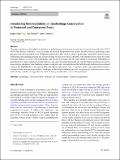Files in this item
Introducing new guidelines on geoheritage conservation in protected and conserved areas
Item metadata
| dc.contributor.author | Crofts, Roger | |
| dc.contributor.author | Tormey, Dan | |
| dc.contributor.author | Gordon, John E. | |
| dc.date.accessioned | 2021-04-08T10:30:21Z | |
| dc.date.available | 2021-04-08T10:30:21Z | |
| dc.date.issued | 2021-03-31 | |
| dc.identifier | 273686300 | |
| dc.identifier | 34ed2a85-8629-43f4-aa5d-157defb17b87 | |
| dc.identifier | 85103814421 | |
| dc.identifier | 000635628600001 | |
| dc.identifier.citation | Crofts , R , Tormey , D & Gordon , J E 2021 , ' Introducing new guidelines on geoheritage conservation in protected and conserved areas ' , Geoheritage , vol. 13 , no. 2 , 33 . https://doi.org/10.1007/s12371-021-00552-0 | en |
| dc.identifier.issn | 1867-2477 | |
| dc.identifier.other | Jisc: 6ebbd2bcf3f54f6185cdaba504cb0834 | |
| dc.identifier.other | publisher-id: s12371-021-00552-0 | |
| dc.identifier.other | manuscript: 552 | |
| dc.identifier.uri | https://hdl.handle.net/10023/22982 | |
| dc.description | The Cultural Heritage Administration, Republic of Korea, funded the design and publication of the Guidelines on which this paper is based. | en |
| dc.description.abstract | This paper introduces newly published guidelines on geoheritage conservation in protected and conserved areas within the “IUCN WCPA Best Practice Guidelines” series. It explains the need for the guidelines and outlines the ethical basis of geoheritage values and geoconservation principles as the fundamental framework within which to advance geoheritage conservation. Best practice in establishing and managing protected and conserved areas for geoconservation is described with examples from around the world. Particular emphasis is given to the methodology and practice for dealing with the many threats to geoheritage, highlighting in particular how to improve practice for areas with caves and karst, glacial and periglacial, and volcanic features and processes, and for palaeontology and mineral sites. Guidance to improve education and communication to the public through modern and conventional means is also highlighted as a key stage in delivering effective geoconservation. A request is made to geoconservation experts to continue to share best practice examples of developing methodologies and best practice in management to guide non-experts in their work. Finally, a number of suggestions are made on how geoconservation can be further promoted. | |
| dc.format.extent | 14 | |
| dc.format.extent | 37466941 | |
| dc.language.iso | eng | |
| dc.relation.ispartof | Geoheritage | en |
| dc.subject | Geoheritage | en |
| dc.subject | Geoconservation | en |
| dc.subject | Protected and conserved areas | en |
| dc.subject | Best practice guidelines | en |
| dc.subject | GE Environmental Sciences | en |
| dc.subject | DAS | en |
| dc.subject | NIS | en |
| dc.subject.lcc | GE | en |
| dc.title | Introducing new guidelines on geoheritage conservation in protected and conserved areas | en |
| dc.type | Journal article | en |
| dc.contributor.institution | University of St Andrews. School of Geography & Sustainable Development | en |
| dc.identifier.doi | 10.1007/s12371-021-00552-0 | |
| dc.description.status | Peer reviewed | en |
This item appears in the following Collection(s)
Items in the St Andrews Research Repository are protected by copyright, with all rights reserved, unless otherwise indicated.

